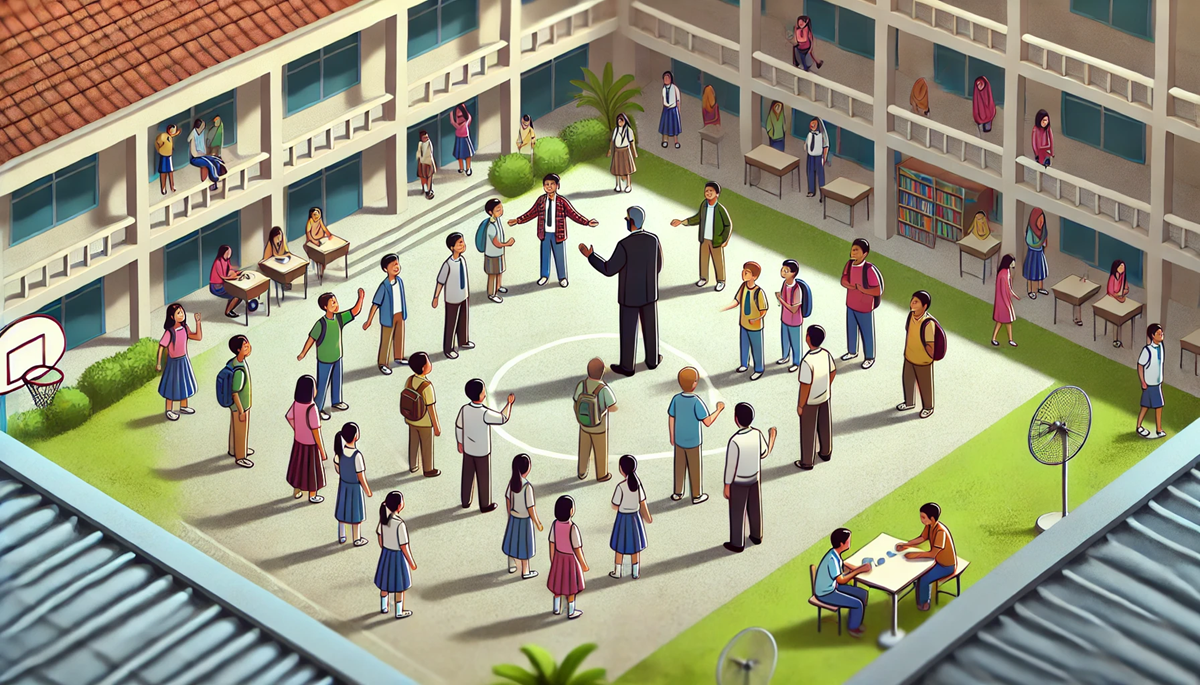The importance of building relationships with students is a theme that is brought up constantly in educational conversations, articles and research.
A trusting relationship needs to exist between the student and the teacher as well as between the student and the school for any deep, eternalized, and transformative learning to occur.
Contents
- 1 Why is it important to build relationships with students?
- 2 How to build good relationships with your students?
- 3 How do you make time to build relationships with students?
- 4 The building blocks of your relationships with students
- 5 The power of names in building relationships with your students
- 6 How I prioritized building relationships with students
Why is it important to build relationships with students?
There is a plethora of information written about the need for building strong and trusting student-teacher relationships available on the internet, in educational articles, and in books published by research academics.
This page on the American Psychological Association’s website does an excellent job of detailing the importance of teacher-student relationships and has links to several articles and videos on how to create these types of relationships and what they should and should not look like.
However, as a Google search and this commentary from the Teachers College Record will show, far more scholarly research focuses on student-teacher relationships than on student-principal relationships. My experience has shown me that there is a need, and a place, for principals to build strong relationships with their students but there is limited research on the topic.
Therefore, principals are often on their own when seeking out information on what building student-principal relationships should look like and/or hope to accomplish. This article by Joanne Rooney promotes the importance of principals building relationships with students, and I found three additional articles on my search here that discuss this topic.
How to build good relationships with your students?
During my tenure as principal, I looked up what the California Professional Standards for Educational Leaders (CPSELs) say about building relationships.
The six standards that principals are meant to master to be effective leaders do not specifically speak to building relationships.
There is a theme running through all six standards (and 9/44 sub standards) that would make it impossible to be an effective leader and meet the standards without creating caring and trusting relationships with students on campus.
See below:


How do you make time to build relationships with students?
Reflecting again on these 9/44 sub-standards reminded me of a common topic of conversation among the principals I work with now: “there is not enough time in the day to meet all of the demands of the job.”
I know the job, and I understand the sentiment, as I felt the same way for a long time. As a reminder to myself of what those time were like, I dug up one of my first employment agreements and job descriptions as principal.
See below:


The 48+ duties listed in the job description say nothing about building relationships with students either, but again, fulfilling several of these duties would be challenging indeed if trusting relationships did not exist.
This organization, like many, conducted yearly student surveys that, along with other metrics, helped determined my overall evaluation ratings for the year.
A statement on the survey that students had to agree or disagree with that always loomed over me all year every year: My principal knows my name. Nothing more.
The simplicity of the statement was daunting and its significance for me was great. It forced me to question how I was or was not connecting with my students to build the relationships that I truly believe matter, especially in an educational environment serving a mostly low-income and high-needs student body. Pondering this statement and whether it was true or not for my students led me to think about what I could do to leverage my busy schedule and position to create positive trusting relationships with my students.
The building blocks of your relationships with students
From my experience as a teacher, I knew the value and importance of building strong relationships with students, and that you cannot have a relationship without having building blocks from which to start.
You need an “in” with kids, something to connect with them on as a pathway to trust.
As a teacher, I had routines, procedures, and prolonged regular periods of time to cultivate these relationships. As principal, the times that I was actively interacting with students on a daily basis was during supervision – arrival, passing periods, nutrition, lunch, dismissal and my late days covering after school activities.
My touch points were regular and often. I needed to figure out some routines and procedures to maximize my time while supervising to build relationships with my students.
The power of names in building relationships with your students
After some thought, I decided that, as a start, learning every student’s name and something about them was my leverage to fulfilling both my job duties and the CPSELs.
It was right after Halloween and all of the stores had candy on sale.
I was a notorious anti-candy, chips and other crap in school, but I decided to use my privilege as principal to break the rules some to help me with my cause: The Name Game – Waller Style.
Starting the first week in November, I played the name game for an entire month. The game and rules were announced at our weekly Monday whole school meeting as I said my closing words. It went something like this:
“I want to get to know you all and all of your names, but I don’t have an opportunity to speak to everyone regularly, so I need your help and you are going to get rewarded for it. For all of November, during nutrition and lunch, please come up to me and ask me if I know your name. If I do, you give me a high five or first bump (I prefer a fist bump myself, I’m just saying) and we move on. If I don’t know your name, and I can’t believe I’m even saying this, you will get to choose one piece of candy from this giant bag of candy that I’ll be carrying around with me all month. Of course, you’ll have to be responsible for eating the candy you choose right away and throwing the trash away and not bring it into the building – all of the normal school rules still apply, but you will be able to enjoy horrible sweet yumminess on campus and in my presence for the purposes of this game. There is one caveat, however, there is a catch, something, that you need to do before you get to choose your candy. The caveat is that you will need to tell me one interesting thing about yourself before you can choose from this bag. Example, if you are sibling to a student that you know I already know, or a cousin to a family of students that I already know, these could be interesting facts. You can share what your hobbies are or your dreams for the future. I learn by making connections and this will help me remember your name. Please, always include your first and your last name in your introduction. You can also tell me how you would like me to pronoun your name right if I get it wrong. This is a process for me, so I may need to practice more than once which is why you can come up to me as many times as you feel necessary and get as many pieces of candy during this month until I get to know you and your name, but only once per break.”
Over the course of the next month, I would carry my sack of post-Halloween sale candy and I slowly started learning the names of my students.
I did get embarrassed several times by not knowing the names of students I had known for a while, but it allowed me the opportunity to properly learn their names and show that I made mistakes like everyone else. I continued this tradition for several years.
The students and I enjoyed it, and it proved helpful in many aspects of the job. The check marks above by the CPSEL and my former job description are there because knowing students’ names, a little bit about them, and the subsequent relationships that developed from this introductory information helped me in all of those areas.
Principal Job Description:
- Carry out and supervise disciplinary consequences for students who violate student code of conduct.
- When you know students and can address them by name if an issue arises, there are fewer discipline problems.
- Maintain communication with the student body in regular community meetings and interactions.
- You speak more to people whose name you know and are familiar with. The game is the start of more interactions with students.
- Promote the general health, safety and welfare of the student body, guiding, supervising, and/or coordinating all student activities to include school related activities outside of regular school hours – i.e. career exploration, field trips, service learning, etc.
- While learning names, you can learn about the students’ families, communities and interests.
California Professional Standards for Education Leaders (CPSELs)
- Identify and address any barriers to accomplishing the vision.
- Students do not learn when they do not feel welcome, wanted, and cared for.
- Promote equity, fairness, and respect among all members of the school community
- Knowing everyone’s name and something about them promotes a belief in equity, fairness, and respect.
- Sustain a safe, efficient, clean, well maintained and productive school environment that nurtures student learning and supports professional growth of teachers and support staff.
- Knowing students and having trusting relationships with them is a great way help maintain a safe campus.
- Utilize effective and nurturing practices in establishing student behavior management systems.
- When you know students and can address them by name if an issue arises, there are fewer discipline problems.
- Establish school structures and processes that support student learning.
- While learning names you can learn about what students feel they need to be successful.
- Incorporate information about family and community expectations into school decision-making and activities.
- While learning names, you can learn about the students’ families, communities, and interests.
- Model personal and professional ethics, integrity, justice and fairness and expect the same behaviors from others.
- Both students and adults were witness to my efforts to increase my interaction with students and learn their names. Walk the talk.
- Encourage and inspire others to higher levels of performance, commitment and motivation.
- If you can learn all of the students’ names, then surely all teachers should know all of their students’ names and something about them.
- View oneself as a leader of a team and also as a member of a larger team.
- Students will learn to view you as a leader and a resource when they get to know you. You will learn to view students more as a resource and leaders of their own learning, once you get to know them.
How I prioritized building relationships with students
My student body was typically between 500 – 550.
I would love to say that I knew all 500+ kids’ names and something significant about them, but there were always a few that I never got to know or could never remember.
I am alright with that and my survey results ended up always being pretty decent. More importantly, I was able to show kids that I cared enough to take the time to get to know to get to know them and that in turn help set the tone for a campus culture of respect and accountability in a school where students knew that relationships with each other and the adults on campus mattered and were something that they could count on.
With those things in place, my team and I were able to make some great things happen with our students and families.
James Waller is a principal coach with Ensemble Learning. You can reach him at jwaller@ensemblelearning.org to continue this conversation about principal-student relationships. To learn more about partnering with Ensemble learning to improve the culture and equity at your school or district, reach out to Ensemble CEO Elise Darwish at edarwish@ensemblelearning.org.



